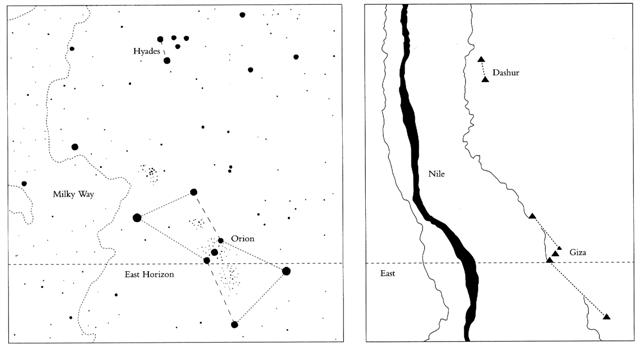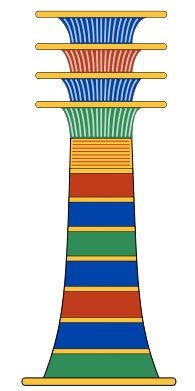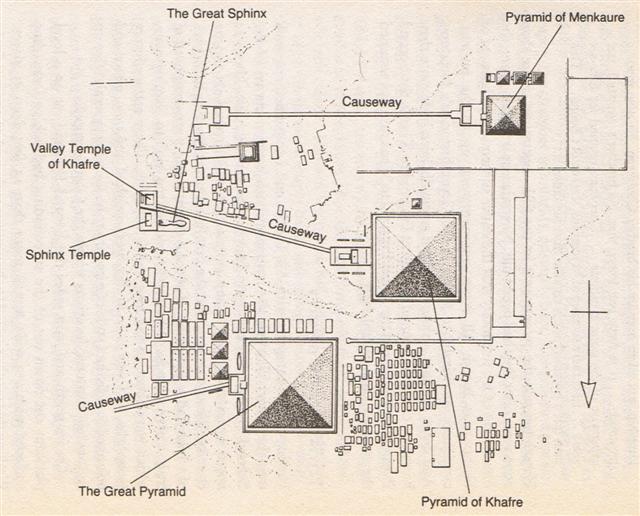192. Midsummer was a cardinal
('heart') point for the Sun. But at the time of
rongorongo Alnilam had not yet
reached
June 21. Instead it was Sirius (at the short
nose of Canis Major), who was the central
star marking where the
new halfyear was about to begin, viz. at the
end of June. And 6 days earlier Canopus
would have been in day 175 (= 350 / 2).
 |
 |
 |
 |
|
Cb3-6 |
Cb3-7 (392 + 56) |
Cb3-8 |
Cb3-9 (450) |
|
ki kikiu - te
henua |
ko te maro - ko te tagata
|
kua hua te tagata |
ko te tagata |
|
CLOSE TO THE FULL MOON
ON EASTER ISLAND: |
|
KHUFU
MINTAKA
(Belt) = δ Orionis,
υ
Orionis (82.4), χ Aurigae
(82.5), ε Columbae (82.6) |
KHAFRE
Al Hak'ah-3 (White Spot) /
Mrigashīrsha-5 (Deer's Head) /
Turtle Head-20 (Monkey) /
Mas-tab-ba-tur-tur (Little
Twins)
ARNEB = α Leporis,
Crab Nebula = M1 Tauri
(83.0,
φ¹ Orionis
(83.1),
HEKA
= λ Orionis,
Orion Nebula = M42
(83.2),
φ² Orionis
(83.6),
ALNILAM
(String of Pearls) = ε Orionis
(83.7) |
MENKAURE
Three Stars-21
(Gibbon) /
Shur-narkabti-sha-shūtū-6 (Star
in the Bull towards the south) /
ANA-IVA-9 (Pillar of exit)
HEAVENLY GATE
= ζ Tauri,
ν Columbae (84.0), ω Orionis
(84.2),
ALNITAK
(Girdle) = ζ Orionis,
PHAKT (Phaet) = α Columbae
(84.7) |
ο
Aurigae (85.8), γ Leporis (85.9)
YANG
MUN (α Lupi)
|
|
... Al Maisān, the title
of
γ
Geminorum, by some error of
Firuzabadi was applied to this
star as Meissa, and is
now common for it. Al Sufi
called it Al Tahāyī; but
Al Ferghani and Al Tizini knew
it as Rās al Jauzah, the
Head of the Jauzah, which it
marks.
The original Arabic name, Al
Hak'ah, a White Spot, was
from the added faint light of
the smaller
φ¹and
φ²
in the background, and has
descended to us as Heka
and Hika.
These three stars were another
of the Athāfiyy [tripods
used for cooking] of the Arabs;
and everywhere in early
astrology were thought, like all
similar groups, to be of
unfortunate influence in human
affairs.
They constituted the Euphratean
lunar station
Mas-tab-ba-tur-tur, the
Little Twins, a title also found
for
γ
and
η
Geminorum; and individually were
important stars among the
Babylonians, rising to them with
the sun at the summer solstice,
and, with
α
and
γ,
were known as Kakkab Sar,
the Constellation of the King
... |
|
June 11 |
12 (163) |
13 (*84) |
14 |
|
"May 1 (11 * 11) |
2 (*42 → 6 * 7) |
3 |
4 |

... Menkaure was
allegedly a much more benevolent
Pharaoh than his predecessors.
According to legends related by
Herodotus, he wrote the
following :
This Prince (Mycerinus)
disapproved of the conduct of
his father, reopened the temples
and allowed the people, who were
ground down to the lowest point
of misery, to return to their
occupations and to resume the
practice of sacrifice. His
justice in the decision of
causes was beyond that of all
the former kings. The Egyptians
praise him in this respect more
highly than any other monarchs,
declaring that he not only gave
his judgements with fairness,
but also, when anyone was
dissatisfied with his sentence,
made compensation to him out of
his own purse and thus pacified
his anger .
The Gods however ordained that
Egypt should suffer tyrannical
rulers for a hundred and fifty
years according to this legend.
Herodotus goes on :
An oracle reached him from the
town of Buto, which said
'six years only shalt thou live
upon this earth, and in the
seventh thou shalt end thy
days'. Mycerinus,
indignant, sent an angry message
to the oracle, reproaching the
god with his injustice - 'My
father and uncle,' he said
'though they shut up the
temples, took no thought of the
gods and destroyed multitudes of
men, nevertheless enjoyed a long
life; I, who am pious, am to die
soon!'
There came in reply a second
message from the oracle - 'for
this very reason is thy life
brought so quickly to a close -
thou hast not done as it behoved
thee. Egypt was fated to suffer
affliction one hundred and fifty
years - the two kings who
preceded thee upon the throne
understood this - thou hast not
understood it'. Mycerinus,
when this answer reached him,
perceiving that his doom was
fixed, had lamps prepared, which
he lighted every day at
eventime, and feasted and
enjoyed himself unceasingly both
day and night, moving about in
the marsh-country and the woods,
and visiting all the places he
heard were agreeable sojourns.
His wish was to prove the oracle
false, by turning night into
days and so living twelve years
in the space of six
... |
 |
 |
 |
 |
 |
 |
|
Cb3-10 |
Cb3-11 |
Cb3-12 |
Cb3-13 |
Cb3-14 (63) |
Cb3-15 (456) |
|
te taketake |
henua |
kiore - henua |
manu rere |
tagata - hanau hia |
kiore - henua |
|
CLOSE TO THE FULL MOON
ON EASTER ISLAND: |
|
μ Columbae,
SAIPH (Sword) = κ Orionis
(86.5),
τ Aurigae, ζ Leporis (86.6) |
υ
Aurigae (87.1), ν Aurigae
(87.2),
WEZN (Weight) = β Columbae,
δ
Leporis (87.7),
TZE (Son) = λ Columbae
(87.9) |
Ardra-6 (Moist One) /
ANA-VARU-8
(Pillar to sit by)
χ¹
Orionis, ξ Aurigae (88.1),
BETELGEUZE
= α Orionis
(88.3), ξ Columbae (88.5), σ
Columbae (88.7)
ZUBEN
ELGENUBI (α Librae) |
η
Leporis (89.0),
PRAJA-PĀTI
(Lord of Created Beaings) = δ
Aurigae, MENKALINAN (Shoulder of
the Rein-holder) = β Aurigae,
MAHASHIM (Wrist) = θ Aurigae,
and γ Columbae
(89.3),
π Aurigae
(89.4), η Columbae (89.7) |
μ
Orionis (90.3), χ² Orionis
(90.5) |
ν
Orionis (91.4), θ Columbae
(91.5), π Columbae (91.6)
|
|
5 days |
6h (91.3)
|
|
June 15 |
16 |
17 (168) |
18 |
19 |
20 |
|
INVISIBLY
CLOSE TO THE
SUN (helical
dates): |
 |
 |
 |
 |
 |
 |
|
Ga1-22 |
Ga1-23 |
Ga1-24 |
Ga1-25 |
Ga1-26 |
Ga1-27 |
|
μ Columbae,
SAIPH (Sword) = κ Orionis
(86.5),
τ Aurigae, ζ Leporis (86.6) |
υ
Aurigae (87.1), ν Aurigae
(87.2),
WEZN (Weight) = β Columbae,
δ
Leporis (87.7),
TZE (Son) = λ Columbae
(87.9) |
Ardra-6 (Moist One) /
ANA-VARU-8
(Pillar to sit by)
χ¹
Orionis, ξ Aurigae (88.1),
BETELGEUZE
= α Orionis
(88.3), ξ Columbae (88.5), σ
Columbae (88.7)
ZUBEN
ELGENUBI (α Librae) |
η
Leporis (89.0),
PRAJA-PĀTI
(Lord of Created Beaings) = δ
Aurigae, MENKALINAN (Shoulder of
the Rein-holder) = β Aurigae,
MAHASHIM (Wrist) = θ Aurigae,
and γ Columbae
(89.3),
π Aurigae
(89.4), η Columbae (89.7) |
μ
Orionis (90.3), χ² Orionis
(90.5) |
ν
Orionis (91.4), θ Columbae
(91.5), π Columbae (91.6)
|
|
June 15 |
16 |
17 (168) |
18 |
19 |
20 |
 |
 |
 |
 |
|
Cb3-16 (457) |
Cb3-17 |
Cb3-18 |
Cb3-19 (68) |
|
henua kua hoi |
kua ka te ahi
o te henua |
o te henua kua
hoi |
ko te henua
kua vero te ahi |
|
Hoki.
To return,
to go back, to
come back; ka hoki ki rį,
go back there! ana oho koe ki
Hiva, e hoki mai ki nei, if
you go to the mainland, do come
back here again. Vanaga.
1. Also, what;
ki ra hoki, precisely there;
pei ra hoki, similitude,
likeness; pei ra hoki ta
matou, usage. P Pau.:
hokihoki, often. Mgv.:
hoki, also, and, likewise.
Mq.: hoi, surely. Ta.:
hoi, also, likewise. 2. To
return, to turn back, to draw
back, to give back, to tack;
mau e hoki mai, to lend;
hoki hakahou, to carry back;
hoki amuri, to
retrograde; hakahoki, to
bring back, to send back, to
carry back, to restore, to
renew, to revoke, to remove, to
dismiss, to pay, to pardon, to
compress; hakahokia,
given up; hakahokihaga,
obligation. P Pau.: hokihoki,
to persist, to insist;
fakahoki, to give back.
Mgv.: hoki, to return, to
retrace one's steps; oki,
to return, to come back. Ta.:
hoi, to return, to come
back. Ta.: mahoi, the
essence or soul of a god.
Churchill.
... The old man realized that he
was now at a critical point. If
the Nazarene did not understand
this business of coming and
going, he would not understand
anything else. He wanted to say
that what made life was not so
much force as the movement of
forces. He reverted to the idea
of a universal shuttle service.
'The rays drink up the little
waters of the earth, the shallow
pools, making them rise, and
then descend again in rain.'
Then, leaving aside the question
of water, he summed up his
argument: 'To draw up and then
return what one had drawn - that
is the life of the world.' |
|
CLOSE TO THE FULL MOON
ON EASTER ISLAND: |
|
SOLSTICE |
June 22 (*93) |
23 (174) |
ST JOHN'S DAY |
|
°June 16 (168 = 80 + *88) |
17 |
18 (*90 =
*94 - 4) |
19 |
|
'May 25 (290 / 2 = 172 - 27) |
26 |
27 |
28 |
|
"May 11
(131 = 172 - 41) |
12 (*52 = *93 - *41) |
13 |
14 |
|
APRIL 18 (108 = 168 - 60) |
19 |
20 |
21 |
|
88 = 168 - 60 |
89 |
90 |
91 |
|
... Midsummer is the flowering
season of the oak, which is the
tree of endurance and triumph,
and like the ash is said to
'court the lightning flash'. Its
roots are believed to extend as
deep underground as its branches
rise in the air - Virgil
mentions this - which makes it
emblematic of a god whose law
runs both in Heaven and in the
Underworld ... The month, which
takes its name from Juppiter the
oak-god, begins on June 10th and
ends of July 7th. Midway comes
St. John's Day, June 24th, the
day on which the oak-king was
sacrificially burned alive. The
Celtic year was divided into two
halves with the second half
beginning in July, apparently
after a seven-day wake, or
funeral feast, in the oak-king's
honour
...
 |
|
INVISIBLY
CLOSE TO THE
SUN (helical
dates): |
 |
 |
 |
 |
|
Ga1-28 |
Ga1-29 |
Ga1-30 |
Ga2-1 |
|
ξ Orionis
(92.5) |
Al Han'ah-4 (The Brand) /
Maru-sha-pu-u-mash-mashu-7
(Front of the Mouth of the
Twins)
TEJAT PRIOR = η Gemini
(93.4), γ Monocerotis (93.5), κ
Aurigae (93.6), κ Columbae
(93.8) |
FURUD
=
ζ
Canis Majoris
(94.9) |
Well-22 (Tapir) /
Arkū-sha-pu-u-mash-mashu-8
(Back of the Mouth of the
Twins)
δ Columbae (95.2),
TEJAT POSTERIOR
= μ Gemini,
MIRZAM ("Roarer") = β Canis Majoris
(95.4),
CANOPUS
= α Carinae
(95.6), ε Monocerotis (95.7), ψ1
Aurigae (95.9) |
|
Egyptian djed |
 |
Phoenician
sāmekh |
 |
Greek
xi |
Ξ (ξ) |
|
... In
rongorongo times
the last Greek
lettered star
in Orion
(ξ)
rose with the
Sun in June 21.
The letter seems
to have
originated from
the Phoenician
letter samekh
(tent peg,
supporting
prop), which in
turn may have
been derived
from the ancient
Egytian djed
column ...
 |
|
Manacle |
ziqq |
Phoenician zayin |
 |
Greek zeta |
Ζ (ζ) |
|
... Zeta
(uppercase
Ζ,
lowercase
ζ;
Greek:
ζήτα
... is the sixth letter
of the Greek alphabet.
In the system of Greek
numerals, it has a value
of 7. It was derived
from the Phoenician
letter Zayin.
Letters that arose from
zeta include the Roman Z
and Cyrillic
З
...
Zayin
(also spelled Zain
or Zayn or simply
Zay) is the
seventh letter of many
Semitic abjads ... It
represents the sound
[z].
The Phoenician letter
appears to be named
after a sword or other
weapon. (In Biblical
Hebrew, 'Zayin'
means sword, and the
verb 'Lezayen'
means to arm. In modern
Hebrew, 'zayin'
means penis and 'lezayen'
is a vulgar term which
generally means to
perform sexual
intercourse and is used
in a similar fashion to
the English word fuck,
although the older
meaning survives in 'maavak
mezuyan' (armed
struggle) and 'beton
mezuyan' (armed,
i.e., reinforced
concrete). The
Proto-Sinaitic glyph
according to Brian
Colless may have been
called ziqq,
based on a hieroglyph
depicting a 'manacle'. |
|

Hamlet's Mill (p. 123):
"This world conception, however, with its
three 'domains', with seven or nine skies,
one above the other, and with corresponding
'underworlds', with the 'world-pillar'
running through the center of the whole
system, crowned by the 'north Nail', or
'World Nail' (Polaris), goes farther back
than Indian and Iranian culture, namely to
the most ancient Near East, whence India and
Iran derived their idea of 'cosmos' - a
cosmos being in itself by no means an
obvious assumption.
The shaman climbing the 'stairs' or notches
of his post or tree, pretending that his
soul ascends at the same time to the highest
sky, does the very same thing as the
Mesopotamian priest did when mounting to the
top of his seven-storied pyramid, the
ziqqurat, representing the planetary
spheres."

|




















